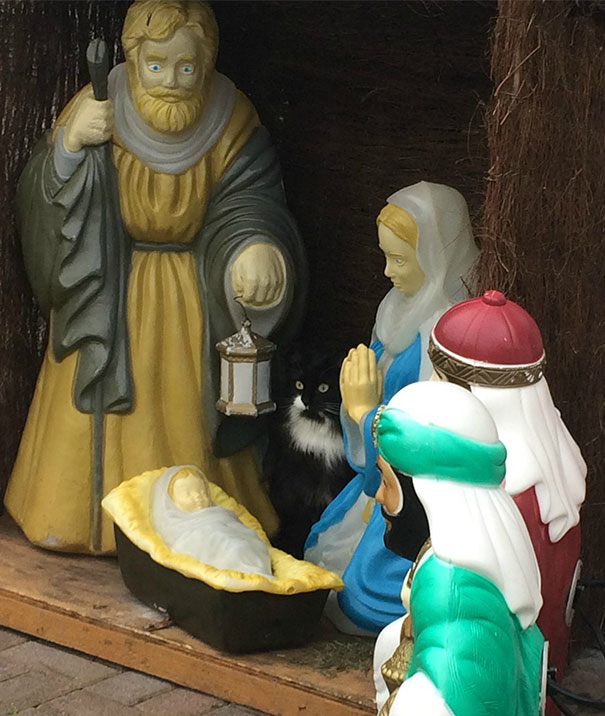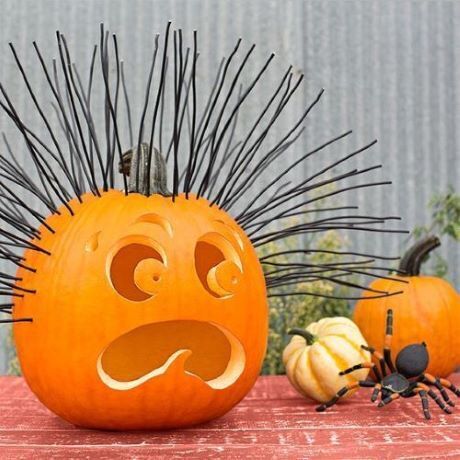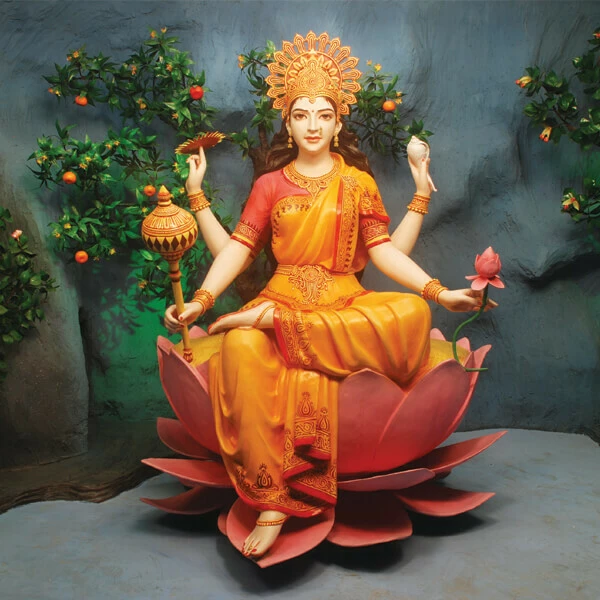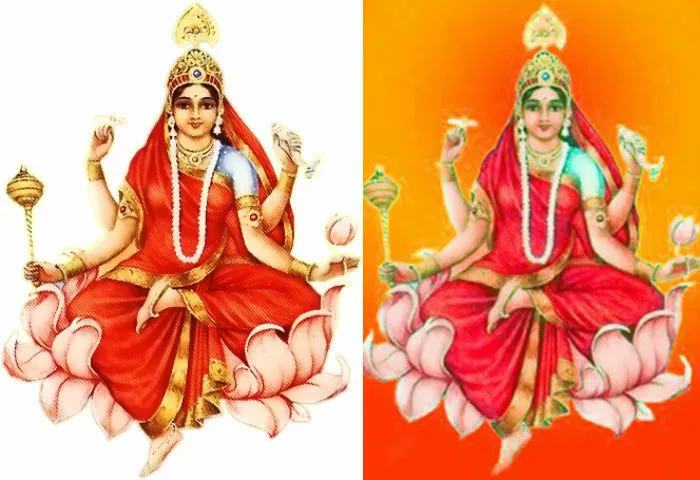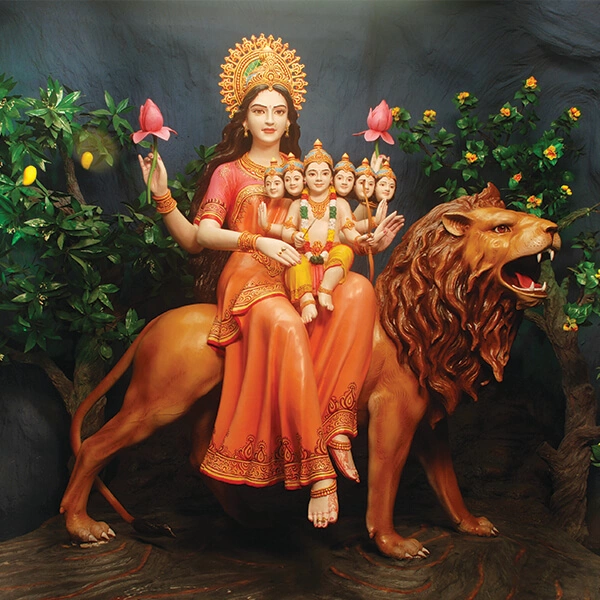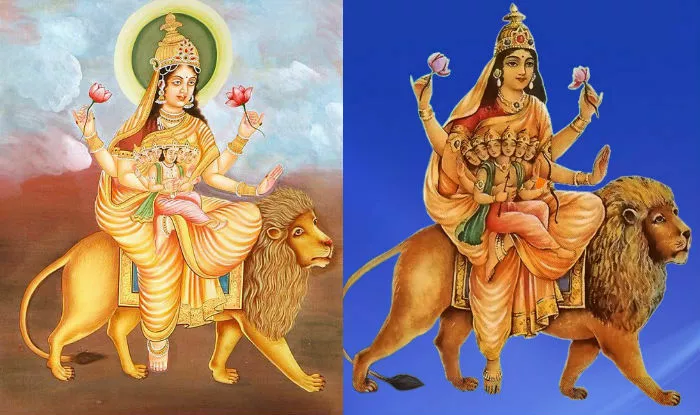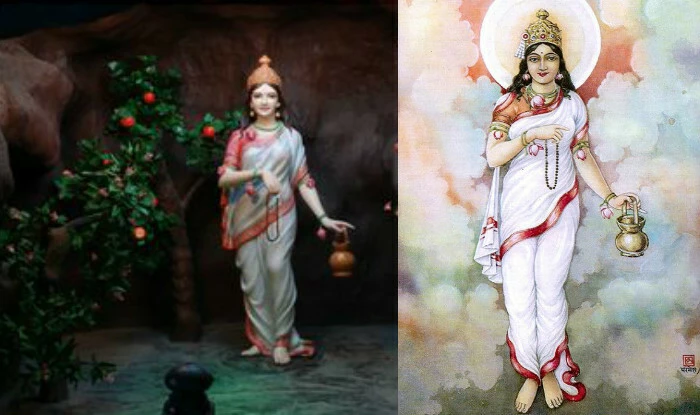#happy
#Happy #Navratri - #Goddess is #Mahagauri.


As the nine nights represent the nine planets, we will be focussing on Navaratri and the nine planets with an account of one or another the planets for nine nights. For the eighth night of Navaratri, we will take the planet #Rahu. The colour for the Eighth day of Navaratri (Ashtami) is purple, so we scribe in #PURPLE for this eighth day observance of Navaratri. The Goddess is Mahagauri.
Today is the eighth day ( #Ashtami) of the Navaratri celebrations which are held for nine nights. All festivals are meant to remind mankind that they should cultivate noble qualities by engaging themselves in activities beneficial to one’s own self and society. Sai Baba made this reference to Navaratri and the Nine Planets:
As part of Navaratri celebrations, people worship different forms of divinity. You should develop sacred feelings and experience divinity. What is the inner meaning of Navaratri celebrations? These nine nights represent nine planets. Each planet has its own significance. However, these planets are not outside, they are within. If your feelings are impure and unsacred, the result also will be the same. You are responsible for the good and bad you think and experience.
Rahu
Rahu is a shadow planet that interrupts the delivery of light to and from the mind, the body, the spirit – as shadows block luminosity, light. The Moon (presiding deity of the mind) is one of the two natural luminaries, the other being the Sun. In Vedic myth, Rahu was formed when the cunning demon Swarbhanu attempted to obtain the nectar of immortality and was beheaded for his efforts. The head is called Rahu, the headless body is called #Ketu. The head is forever seeking, desiring wholeness and this explains to us how Rahu is significator of desire, and fraud; Rahu fraudulently sat among the gods to receive the nectar and his deception was exposed by Sun and Moon. Hence the eternal animosity of Rahu to #Sun (causes #eclipses) and #Moon (bedims Moon).
At a glance, Rahu is called the North Node, is exalted in GEMINI #ARDRA , co-lord of Aquarius (with Saturn) and has digbala (directional strength) in the 10th house. Rahu magnifies the effect of its Lord, and that of any planet it is conjunct. Rahu is of vata (airy) nature and rules the astral and possessions. Medically, Rahu is giver of incurable chronic diseases, snake bite, difficulties in breathing, chronic illness and mental illness.
Rahu signifies worldly desires, foreign lands, use of drugs and alcohol, separation, harsh and grating speech, insanity, fear and adversity, and the status of Rahu is out-caste. Rahu is said to be self-seeking, a deceiver, manipulator, ambitious and generally dissatisfied with life. There is always more, and Rahu, chalakaraka, (giver of fraud) will obtain more by any means possible. Rahu is always dissatisfied and seeks validation, higher status and office. Rahu – by fair or foul means – will take possession of any instrument that will empower the ego. Position, pride, greatness. In these affairs, Rahu cannot control himself. With Rahu, Station in life is nearly always improperly obtained and cannot be sustained as fraud is usually exposed soon after.
We began saying Rahu signifies desires. In fact, due seeking of desires, Rahu is the one planet that is said to cause reincarnation, which happens when desires remain unfulfilled. Desires are due discontent, seduction (of the mind) and mental delusion. There are the haves and have-nots in this world, and Rahu – who wants what he sees – goes around the rules, disregards boundaries and is always hungry for more. Rahu always surges with desire for the next thing, unhappy with anything that has been obtained. Think of cars on the highways and byways that have to overtake you and are disconsolate to stay on the speed limit and follow the laws of the road – unhappy at any speed – and you get an idea of Rahu.
Goddess Mahagauri
The name Mahagauri means extremely white, as she was white in colour and very beautiful (Mahā=great; Gaurī=white). Mahagauri is usually depicted with four hands, the hands holding a trident, lotus and drum, while the fourth is in a blessing gesture. The lotus is sometimes replaced with a rosary. She rides a white bull, usually shown wearing white clothes.
It is believed that the 16 year old unmarried Goddess Parvati wanted to marry Lord Shiva and, as such, did rigorous penance (tapasya) for a very long time to please him. Because of this, she ended up facing a lot of hardships and her complexion turned dark with dust, heat and starvation. Lord #Shiva, however, was pleased with her penance and agreed to marry her. Using the Ganges water flowing out of his matted hair, he washed her clean. Consequently, her white clothes and fair complexion started glowing radiantly again. Since then, she is known as Mahagauri.
#Mother #Gauri is #Devi, #Shakti or the Mother Goddess, who appears in many forms, such as #Durga, #Parvati, #Kali and others. She is auspicious, brilliant and protects the good people while punishing those who perform evil deeds. Mother Gauri enlightens the spiritual seeker and removes the fear of rebirth by granting salvation.
Significance of Navaratri
“Men are prone to exhibit rajasic (active, excitable) qualities like anger and hatred. They are menacing manifestations of Durga. The extolling of the Divine in song and poetry and the pleasing vibrations produced by them indicate the power of Saraswati. The pure qualities that arise in man such as compassion, love, forbearance and sympathy are derived from Lakshmi. When people worship Durga, Lakshmi and Saraswati externally in pictures or icons, they are giving physical forms to the subtle potencies that are within them. The unfortunate predicament of man today is that he is not recognising the powers within him and developing respect for them. He goes after the external, attracted by the physical forms. The relationship between the material and the subtle has to be understood.” Sai Baba, SS, 11/94, p. 284
#Happy #Navaratri Day 7 – #Saturn
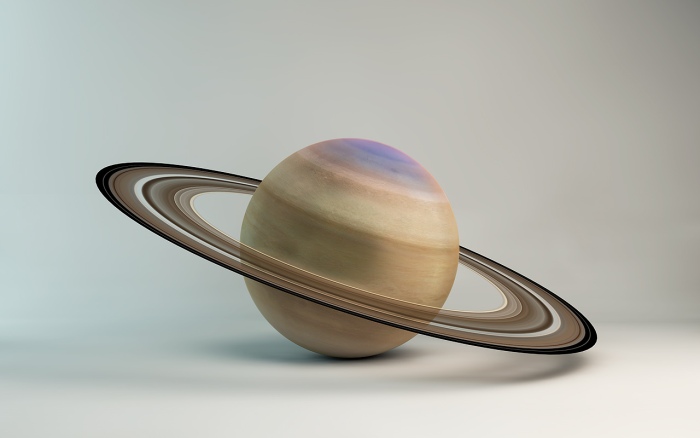
As the nine nights represent the nine planets, we will be focussing on Navaratri and the nine planets with an account of one or another the planets for nine nights. For the seventh night of Navaratri, we will take the planet #Saturn. The colour for the seventh day of Navaratri is grey, so we scribe in #GREY for this seventh day observance of Navaratri. The #Goddess is #Kalaratri.

Today is the seventh day of the Navaratri celebrations which are held for nine nights. All festivals are meant to remind mankind that they should cultivate noble qualities by engaging themselves in activities beneficial to one’s own self and society. Sai Baba made this reference to Navaratri and the Nine Planets:
As part of Navaratri celebrations, people worship different forms of divinity. You should develop sacred feelings and experience divinity. What is the inner meaning of Navaratri celebrations? These nine nights represent nine planets. Each planet has its own significance. However, these planets are not outside, they are within. If your feelings are impure and unsacred, the result also will be the same. You are responsible for the good and bad you think and experience.
Saturn
Many consider Saturn as terrifying among the planets! It is said that all beings fear him for he rules bereavements and misfortunes. He is master of sudden reversals, so thorough that one’s name may well be forgotten among the annals of mortals. His gaze (drishti) is directed downwards for it is utterly destructive. There is a tale of Parvathi wanting a new abode in Kailash, and when Shiva (finally) granted the wish for an abode, Lord Brahma demurred and told, “Not wise, not wise!”, for he could sense the gaze (drishti) of Saturn would bring matters to grief. Shiva went to ask Saturn/Shani to avert his gaze from the new house. To cut a long story short, there was misunderstanding of the signals, Shiva beat his drum (dhamaru) (because he was doing the Tandava dance for Saturn), Parvati misunderstood the message and burned the house down. The moral of the story is that none may escape the drishti of Saturn.
Lord of the sinews, the West and Saturdays, his constellations are Capricorn (Makara) and Aquarius (Kumbh). He is Lord of three Nakshatras, Pushya, Anuraada and Uttara Bhadri. He is also known as the Slow, the Son of the Shadow, the Angular, the Black, the Endless, the End-Causer, the All-Devouring, the Steady, the Controller, the Famished, the Emaciated. His name in Sanskrit is Shanicharaya, “the slow-moving preceptor, the teacher who moves slowly”. Saturn has the slowest movement among the visible planets.
Traditional matters associated with Saturn are disease, death and the dying process – all of these are human and inescapable – the cause of death is birth. One of the main tasks of Saturn/Shani is said to be the cause of disenchantment – and therefore detachment from the ephemera, the fleeting, pointless, meaningless distractions and prattle of life.
Goddess Kalaratri
Goddess Kalaratri, also known as Mother #Kaali, is the seventh form of Goddess #Durga. Devotees worship her on the seventh day of Navaratri. They seek her blessings to eliminate all troubles from their lives.
This form of Durga is believed to destroy all demons, ghosts and negative energies. She is also believed to be the destroyer of time and death. Although, intimidating in appearance, Goddess Kalaratri is benevolent towards all worshipers.
There are many mythological stories that tell us about the transformation of Goddess Durga into Goddess Kalaratri. According to the most common legend, two demons Shumbha and Nishumbha invaded and defeated the realm of demigods. The demigods prayed to Goddess Parvati for help. Parvati readily transformed herself into Goddess Chandika, to battle with demons on behalf of all devas (gods). Goddess Chandika (also known as Chamunda) transformed herself into Goddess Kalaratri and killed both these demons. Goddess Kalaratri fought another demon called Raktveej and kept drinking his blood till he was completely dead, causing her tongue to appear blood-red.
Her vehicle is the #donkey; she has four arms and a blood-red tongue. Goddess Kalaratri is generally portrayed in a dark colour (usually dark blue) and appears to be somewhat wild-looking and threatening. Two arms are holding sabre and lance for slicing off heads; her other arms are held up on abhaya (protection) and varada (blessings, boons) for her devotees.
Saturn and the Feminine
When we look to Saturn we think duty, discipline, responsibility, doing things slowly and getting them right and advancing in life, slowly, carefully. Consider that these are activities Mothers, wives and sisters impart to us as we journey through life. Love that is given by the feminine principle is bounded by discipline and responsibility and considers the long term goal: true humanness. True humanness is a life informed by life-enhancing values, feelings, thoughts and behaviour. Therefore mothers – and all who embody the feminine – take up their task with duty, discipline and responsibility. This love is not dependent on like nor dislike, giving and receiving. The love that the feminine gives – informed by the qualities and and energy that Saturn gives – sees beyond like and dislike, differences between things and focuses on the end goal. True humanness, which forges new higher expressions of life even in the midst of life’s seeming dissolution.
Significance of Navaratri
“The Navaratri festival should not be observed as a festival for worshipping the consorts of Vishnu, Shiva and Brahma. These goddesses symbolise divine potencies. All these potencies are derived from Vishnu. The entire cosmos is a manifestation of the myriad forms of Vishnu. People must recognise this oneness underlying the different forms. All beings breathe the same air as their life-breath. Likewise all the five basic elements are the stuff of nature. But in the Para-Tattwa (the Supreme Principle, the Divine), these do not exist. The elements are mortal. The Divine is immortal. To proceed from the mortal to the immortal, the easiest means is the cultivation of the Divine Love (Prema).
The heart is like a sky wherein the clouds in the form of thoughts hide the Buddhi (the intellect) and the mind representing the sun and the moon. Vairagya (detachment) is the means to get rid of thoughts and desires arising from them. The Devi Puja performed during Navaratri is intended to get rid of worldly attachments and divert the mind toward God. There are four different qualities in man: humanness, the animal nature, demonic nature, and divine nature. When man follows the dictates of the body, he is a prey to his animal nature. When he is subject to the vagaries of the mind, he becomes demonic. When he is following the Atma (conscience), he is manifesting his divinity. When he is governed by all the three- the body, the mind and the Atma, he is human”. Sai Baba, SS, 12/92, p. 305
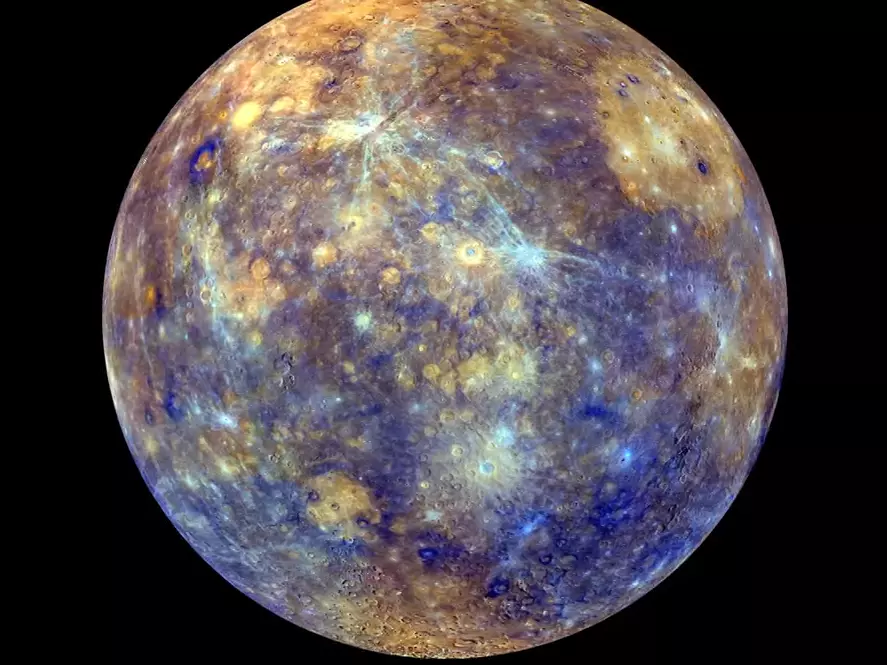
#Happy #Navratri Day 4 – #Mercury

As the nine nights represent the nine planets, we will be having a planetary observance of Navaratri with an account of one of the planets for each of the nine nights. The fourth day of Navaratri is marked to #worship #Goddess #Kushmanda. The Fourth planet is Mercury. It is said that one should wear royal blue on this day, as it is considered good for health and wealth. Our colour for this day is #Royal-Blue!
Today is the fourth day of the Navaratri celebrations which are held for nine nights. All festivals are meant to remind mankind that they should cultivate noble qualities by engaging themselves in activities beneficial to one’s own self and society. Sai Baba has told that Navaratri, the nine nights, represents the Nine Planets.
In Hindu mythology, Navaratri celebrates the victory of Goddess Durga over Mahishasura, the buffalo-headed demon. She fought for nine days and nine nights before emerging victorious on the tenth day. Goddess Shakti in the nine forms is worshipped during the period for knowledge, wealth, prosperity and auspiciousness. Knowingly or unknowingly during this period we also recognise the primordial source of energy (Shakti), which manifests in all living and nonliving.
Sai Baba went on to say that each planet has its own significance. However, these planets are not outside, they are #within. So we take the opportunity to examine the energies of the planets within, and examine how the #Divine #Mother is related to these energies.
Mercury
Mercury is also known in #VedicAstrology as #Budha, the awakened discriminating #intellect – the part of us that knows. Mercury owns two signs, Gemini and Virgo. Mercury is exalted in Virgo at 15 degrees, and debilitated in the opposite sign, Pisces. Where the Moon is the innocent mind, Mercury is the intellect that discriminates between benefic and malefic ideas, or good and evil. Mercury is adept at dealing with duality.
Mercury does not have a distinctive personality of its own; it takes on features of the planets which are associated with it. Mercury, planet of communication, articulates and expresses whatever influence it receives from other planets. For this reason, brilliance of expression, adjustment and flexibility are common traits of Mercury. Mercury traditionally has the function of Messenger of the Gods; Mercury functions to take messages from Gods to Man and from Man to the Gods.
Mercury develops intellect. Taking duality, it enables the subjectivity of an idea to be objectified, and helps to understand the inner reality of external phenomenon. A favourable disposition of Mercury renders perceptive, clever persons who are good debaters, who can argue either side of a question and thus, we can often find that Mercury is strong in the chart of lawyers. Mercury is intellectual and careful with details.
Day Four
Goddess Kushmanda
Kusmanda – She Who brings #happiness
Kushmanda is a Hindu goddess, credited with creating the world with her divine #smile. Legend has it that Lord Vishnu was able to begin the creation of universe, when Goddess Kushmanda smiled and receded. She represents that form of Durga which is the source of all. Her name signals her main role: Ku means “a little”, Ushma means “warmth” or “energy” and Anda means “cosmic egg”.
Kushmanda is worshipped on the fourth day of the festival of Navaratri and She is believed to improve health and bestow wealth and strength. Goddess Kushmanda has eight hands and because of that She is also known as Ashtabhuja Devi. It is believed that all the power to bestow Siddhis and Niddhis are located in her japamala (rosary beads).
Legend has it that Goddess Durga gives birth to the universe in the form of Goddess Kushmanda. She is also sometimes depicted as pregnant with the Brahmand or universe. It is believed that the eternal darkness ended when she smiled. And this led to the beginning of creation. This form symbolises that Shakti is the primordial source.
Mercury and the Feminine
Vedanga – Jyotish ( #astrology texts) – tell us that Mercury is hermaphrodite, meaning s/he is bearing signification of both genders. It is more appropriate to say that Mercury is androgynous, neither male nor female. Androgyny is also known in this day and age as intersex.
Just as the Creation narrative has Kushmanda and Vishnu at the cause of Creation, so also we see the emergent glance of the androgynous Mercury, encapsulating this act of creation with the dual genders.
We have clues to the important role and function Mercury has with regard to the mind, the intellect and duality. #Shakti is the prime force behind all dualities and Shakti can be found linking subject and object, in the glance of Mercury. The mind is an energy field of Shakti with neuronal impulses and connections, creating an elaborate web of knowledge and self interest (referring to the autonomic nervous system and instinctive responses of the body.) The mind is a bundle of thoughts bound together by the shakti of memory. Thinking is guided by the intellect – which is called buddhi in Sanskrit. The buddhi is nearest the Soul and derives over 90% of its illumination from the Soul.
Significance of Navaratri
“During these sacred nine days (Navaratri), people go through the sacred texts such as Devi Bhagavatam, Ramayana and Mahabharata. People also worship the deities Durga, Lakshmi and Saraswati. Goddess Gayatri is the presiding deity of our senses. Savitri is the presiding deity of speech. All these three are within the same Principle of Truth. Gayatri Mantra begins with ‘Om Bhur Bhuvah Svah’. ‘Bhuh’ means materialization (Body); ‘Bhuvah’ means Vibration (Life Principle); Svaha means Radiation (Atma).
During these nine days, Goddess Shakti (Energy Principle) is worshipped. Truth, righteousness, peace, forgiveness are all expressions of the Principle of Shakti. Truth is the primal cause. There is nothing other than this. All faculties of energy are present in this Truth. So, consider Truth as your mother and follow it. The Vedas proclaim, ‘Satyam Vada; Dharmam Chara‘, which means speak the truth and follow the righteousness. Unfortunately, today people do not follow this. On the contrary they follow Asatya (untruth) and Adharma (unrighteousness)” Sai Baba. SS, 11/98, p. 284


As the nine nights represent the nine planets, we will be focussing on Navaratri and the nine planets with an account of one or another the planets for nine nights. For the third night of Navaratri, we will take the planet #Mars. The third day of Navratri is #Sindoor Tritya. The colour for the third day of Navaratri is #RED, so we scribe in RED for this third day observance of Navaratri. The #Goddess is #Maa #Chandraghanta.
Today is the third day of the Navaratri celebrations which are held for nine nights. All festivals are meant to remind mankind that they should cultivate noble qualities by engaging themselves in activities beneficial to one’s own self and society. Sai Baba made this reference to Navaratri and the Nine Planets:
As part of Navaratri celebrations, people worship different forms of divinity. You should develop #sacred feelings and experience divinity. What is the inner meaning of Navaratri celebrations? These nine nights represent nine planets. Each planet has its own significance. However, these planets are not outside, they are within. If your feelings are impure and unsacred, the result also will be the same. You are responsible for the good and bad you think and experience.
Sindoor Tritiya is observed on the third day of the 9-day Navaratri festival. On this day Maa Chandraghanta is worshipped. This day is of great significance in North India. This is a ritual during Navaratri, which is closely associated with Sindoor – the red powder or #Vermilion – which is an essential part of Hindu ritual and closely associated with Mother Goddess worship.
This day also marks the end of the first three days of Navaratri, especially in South India. The first three days of Navratri are dedicated to Goddess #Durga. The next three days are dedicated to Goddess Lakshmi.
Mars
The Planet Mars is known in #VedicAstrology as #Kuja, the Commander in Chief, son of Bhumi, Mother Earth, (or Bhoomi Devi), and is dispositor or karaka of shakti in the form of energy, will, power and strength. Mars is a planet of strength. The sloka for Mars describes this planetary deity has having the (weapon or instrument) Shakti in his hand. So we may take strength, power, energy and force as signatures of Mars.
So we understand that Mars, with the instrument of Shakti, has power, energy and will. Application of will to physical energy and efforts gives rise to power, concentration and success in the formation of discipline to create human order in human society. Mars, with its command of energy for repetition, practice, drill, gives penetration of mind and intellect to efficient decisions, which create order where disorder and chaos exist.
There are five elements: earth, air, fire, water and ether (space). These represent the different layers of manifestation from the subtle universe to the material, 3 dimensional world. The three gunas (impulses, drives to action or inaction) work through the five elements to form the outer world and sustain the bodies of the individual souls that take birth. There are shaktis of space, air, fire, water and earth within our bodies. Fire, which Mars is a significator of, has the powers to create great heat in furnaces and foundries, to controlled heat in turbines and kitchen stoves, to ripen and to impart colour. It represents electrical energy inherent in space, activated by the air element and gaining luminosity, and thus giving forth the power of light.
Day 3
Goddess Chandraghanta
Chandraghanta is the third form of Goddess Durga. Her name Chandra-Ghanta, means “one who has a half-moon shaped like a bell. Her third eye is always opened and she always ready for war against demons. She is also known as Chandrakhanda, Chandika or Rannchandi. Her worship takes place on the third day of Navaratri. She is believed to reward people with her grace, bravery and courage. By her grace all the sins, distresses, physical sufferings, mental tribulations and ghostly hurdles are eradicated.
Chandraghanta is one who establishes justice and discipline in the world. The color of her body is golden; she rides on the lion that represents dharma (righteousness, right conduct); she possesses ten hands and three eyes; eight of Her hands display weapons while the remaining two are respectively in the mudras of boon giving and stopping harm. Chandraghanta is posed as if to be ready for war. Chandra+Ghanta means supreme bliss and knowledge, showering peace and serenity, like cool breeze in a moonlit night.
Mars and the Feminine
We mentioned earlier that Mars has Shakti as his instrument. The Kuja (Mars) Gayatri speaks of Mars as shakti hastaya dheemahi, that Mars carries the flag of Shakti, which is feminine in nature and represented by Goddess Durga. Mars is the son of Bhoomi Devi, Mother Earth, which also makes Mars vehicle or carrier of the feminine shakti.
Durga is the Goddess of War; Mars is the warrior serving the Goddess. Mars is the General, the warrior in chief. Mars is Bhoomi Putra, Son of Mother Earth. The role of shakti which Mars has – as Son of the Earth Mother – becomes more directed towards transformation. Force, Power and Command may be directed towards understanding, collaboration, devising alternate strategies to negativity, wars and conflicts. This is ParaShakti, the Mother Goddess, in action.
Significance of Navaratri
The term “Devi” thus represents the Divine Power which has taken the Rajasic form to suppress the evil forces and protect the Satvic qualities. When the forces of injustice, immorality and untruth have grown to monstrous proportions and are indulging in a death dance, when selfishness and self-interest are rampant, when men have lost all sense of kindness and compassion, the Atmic principle, assuming the form of Shakti (energy/ power), taking on the Rajasic quality, seeks to destroy the evil elements. This is the inner meaning of the Festival. When the Divine Goddess is in dreadful rage assumes a fearful form, to pacify the dreaded Goddess, her feminine children offer worship to Her with red kumkum (sacred powder). The Goddess seeing the blood-red kumkum at Her feet, feels assured that the wicked have been vanquished and assumes Her benign form. The inner meaning of the worship of “Devi” with red kumkum is that thereby the Goddess is appeased. During the ten days of Navaratri and Dassera the demons in the form of wicked qualities have been routed. Rakshasas (demons) do not mean demonic beings. Arrogance is a demon. Bad thoughts are demons”. (Sai Baba, SS, 11/91, pp. 284 – 285)
#Music on #Blue-Galactic-Eagle
#JohnMcGeoch 5/28/1955 #Birth Scottish musician ( #SiouxsieAndTheBanshees )
https://www.youtube.com/watch?v=37PKcsvD0hg
#Happy #House


